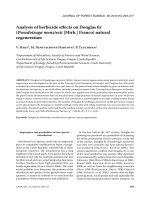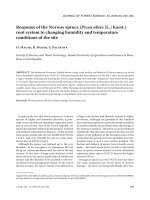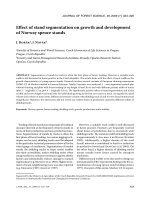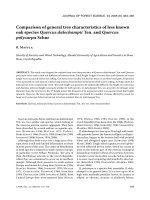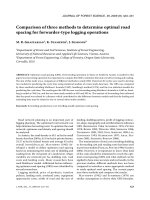Báo cáo lâm nghiệp: "Comparison of two types of ECOLURE lure on Ips typographus (L.) (Coleoptera: Scolytidae)" doc
Bạn đang xem bản rút gọn của tài liệu. Xem và tải ngay bản đầy đủ của tài liệu tại đây (638.47 KB, 5 trang )
J. FOR. SCI., 56, 2010 (12): 609–613 609
JOURNAL OF FOREST SCIENCE, 56, 2010 (12): 609–613
Comparison of two types of ECOLURE lure
on Ips typographus (L.) (Coleoptera: Scolytidae)
O. N
1
, J. S
2
1
Department of Forest Protection and Game Management, Faculty of Forestry and Wood
Sciences, Czech University of Life Sciences Prague, Prague, Czech Republic
2
Svatonice, Písek, Czech Republic
ABSTRACT: The efficiency of two types of pheromone dispensers (ECOLURE classic and ECOLURE tubus) was
compared in 2008. Pheromone-baited traps were checked 13 times in 10-day intervals (this guaranteed the efficiency
of ECOLURE tubus all time). ECOLURE classic trapped more beetles on average in all samples. Differences among
the first 4 samples (checkings) were statistically insignificant, differences among another 9 samples were significant
(used statistic tests – two choice t-test, α = 0.05 from data with normal distribution, Wilcoxon matched pairs test in
the case of other data distribution).
Keywords: ECOLURE; efficiency; Ips typographus; pheromone dispenser
Supported by the Ministry of Agriculture of the Czech Republic, Project No. 81136
Ips typographus is one of the most serious pests
of spruce stands in Eurasia (B 1989). Using
trap trees has always been the basic tool of forest
protection against this pest. In the last several de-
cades pheromone traps have replaced trap trees in
a massive way. e efficiency of pheromone traps as
a measure of forest protection is still discussed by
many authors (e.g. D et al. 1992; L,
S 1996; W, R 2001). It was
calculated that using a high density of pheromone
traps only 3-10% of the bark beetle population may
be trapped (W, L 1990; L,
S 1996). To ensure the right functional-
ity of pheromone traps, the traps must be lured
by pheromone dispenser. A key component of the
bait is cis-verbenol (e.g. J, B 2002).
But the number of trapped beetles is strongly de-
pendent on many environmental factors and lo-
cal conditions, such as temperature, sun exposure
and others (L 1995). e type of used
dispenser is a very important non-environmental
factor. E.g. Z et al. (1990) compared the
efficiency of PHEROPRAX and IT ETOKAP. J
and Š (2000) compared IT ECOLURE (with
6 different levels of release rates) and PHEROPRAX
at pheromone trap barriers. e type of dispenser
wrapper must allow a steady release of the effec-
tive quantity of pheromone active compounds for a
long time. e type of this wrapper may play a sig-
nificant role in the number of trapped beetles. e
efficiency of 2 types of pheromone dispenser with
the same chemical components packed to 2 differ-
ent wrappers is compared in this paper (the first
type is ECOLURE TUBUS, the second ECOLURE
CLASSIC
MATERIAL AND METHODS
Investigated pheromone dispenser
and aim of research
Two types of pheromone dispensers were in-
vestigated in this experiment. ECOLURE TUBUS
guaranteed the efficiency of 18–20 weeks. Twenty
weeks were considered as the time to compare the
second type of lure – ECLURE CLASSIC (with
the efficiency of 5 weeks after the first opening of
610 J. FOR. SCI., 56, 2010 (12): 609–613
wrapping bag, after the second larger opening of
the same wrapping bag the efficiency is prolonged
by another 7–10 weeks). IT ECOLURE CLASSIC
(rank VYR IT 04 08·05) and IT ECOLURE TUBUS
(rank 04·08··02) were used. Both are pheromone
dispensers for Ips typographus compounded of (S)-
cis-verbenol (3%), alcohols and solvents (85.2%)
and synergic components (11.8%). ECOLURE
CLASSIC contains 2.5 g of effective compounds
and ECOLURE TUBUS 3 g. e basic difference
between them is in the construction of the dis-
penser wrapper. Effective compounds are packed
in a classic clipping bag in the case of ECOLURE
CLASSIC, and in a special transparent plastic tube
with free filling in the case of ECOLURE TUBUS.
Spatial experiment design
e study was conducted near the town of Písek
(south Bohemia) in the Záhoří management-
plan area located near the village of Záhoří (loc:
49°21'1"N, 14°12'1"E). Twenty pairs of pheromone
traps of eyson type were installed in the for-
est complex. Pheromone traps were located on
clearcuts at distances of 15 m from the forest edge
(according to the recommendation of the phero-
mone dispenser producer). A distance between
traps in pairs was 70 m. Both traps in pair were al-
ways installed only on the linear forest edge (be-
cause of the same point of the compass). High weed
growth was suppressed by herbicides 1.5 m around
the trap. ECOLURE CLASSIC type of pheromone
lure was put into the first pheromone trap in pair
and ECOLURE TUBUS into the second one.
Timing experiment and measurement
of trapped beetles
e time of comparative experiment was as-
sessed according to the guaranteed time of ECO-
LURE TUBUS – it means 18–20 weeks (19 weeks
were used).
Pheromone traps were installed on 13
th
April
2008 and they were lured by pheromone dispensers
on 25
th
April. Traps were controlled every 10
th
day
till the 3
rd
September.
e first bag with the efficient substance of
ECOLURE CLASSIC was more opened by scis-
sors on 1
st
June and replaced by the second one on
7
th
July. e second was more opened on 13
th
June
and replaced by the third one on 16
th
July. e third
one was more opened on 15
th
August and replaced
by the fourth on 24
th
August, which was not more
opened later.
e number of trapped beetles was always count-
ed by means of a calibrated glass cylinder because
it is assumed that 1 ml of eight-toothed spruce bark
beetles is equal to 35 individuals.
Data analysis
STATISTICA 8.0 software was used for data anal-
ysis. Data normality was tested by Kolmogorov-
Smirnov test. Significance of differences between
the numbers of trapped beetles (between ECOLU-
RE CLASSIC and ECOLURE TUBUS) was tested
by t-test (dependent samples) in the case of normal
data distribution and by Wilcoxon matched pairs
test in the case of other data distribution. Differ-
ences in ten-day checkings and also in the total sea-
sonal number of trapped beetles were tested.
Relative efficiency was calculated for single
checking as the ratio of the number of trapped
beetles by ECOLURE CLASSIC to the number of
beetles trapped by ECOLURE TUBUS (C/T index).
Differences between C/T indexes were calculated
as follows: C/T index
(during checking x)
divided by C/T
index
(during checking x–1)
.
RESULTS
Obtained data
During the whole tested period 418,151 individu-
als of Ips typographus were trapped to all 40 phero-
mone traps. 285,996 individuals were captured to
the pheromone traps lured by ECOLURE CLAS-
SIC and 132,155 individuals lured by ECOLURE
TUBUS. It means that ECOLURE CLASSIC was
2.2 times more effective than ECOLURE TUBUS.
Summary data for all 20 pairs and for single
checking are presented in Fig. 1. ere are two ob-
vious peaks of swarming – the first peak in spring
(May8
th
) and the second in summer (July 7
th
). ere
is one lower in between peak which represents the
sister generation of spring swarming (Fig. 1).
Comparison of efficiency
Pheromone traps lured by ECOLURE CLASSIC
captured a higher number of beetles than ECOLU-
RE TUBUS during all checkings (from 1.1. to 36.6
times more – see the C/T index in Fig. 1). During
spring swarming (checking on May 5
th
–June 7
th
)
J. FOR. SCI., 56, 2010 (12): 609–613 611
ECOLURE CLASSIC trapped 1.1–1.6 times more
but the differences were not significant (α = 0.05) –
Table 1. From this aspect possible efficiency of both
lures can be considered the same in this period.
en the relative efficiency of ECOLURE CLASSIC
increases.
During the second swarming (June 17
th
to Septem-
ber 3
rd
) the relative efficiency of ECOLURE CLASSIC
increased from 2.2 to 36.6. After 1.5 month ECOL-
URE CLASSIC trapped twice more beetles, more
than 4 times more after 3 months and more than
20 times more after 4 months. Differences between
1,162.00
1,109.00
1,300.25
1,699.25
1,178.75
1,042.00
1,764.00
3,454.50
1,732.50
3
8.00
19.6
36.6
15.0
20.0
25.0
30.0
35.0
40.0
1,500
2,000
2,500
3,000
3,500
Rate of trapped beetles (CLASSIC/TUBUS)
e
r of trapped beetles to the 20 pheromone traps
1,162.00
1,109.00
330.95
666.00
318.55
614.25
1,300.25
707.00
215.95
125.00
38.50
17.00
3.30
1,699.25
1,178.75
421.40
1,042.00
691.25
1,764.00
3,454.50
1,732.50
938.00
689.90
234.00
333.50
120.75
1.5
1.1
1.3
1.6
2.2
2.9
2.7
2.5
4.3
5.5
6.1
19.6
36.6
0.0
5.0
10.0
15.0
20.0
25.0
30.0
35.0
40.0
0
500
1,000
1,500
2,000
2,500
3,000
3,500
8. 5. 18. 5. 28. 5. 7. 6. 17. 6. 27. 6. 7. 7. 16. 7. 26. 7. 5. 8. 15. 8. 24. 8. 3. 9.
Rate of trapped beetles (CLASSIC/TUBUS)
Number of trapped beetles to the 20 pheromone traps
Data of pheromone-traps checking (guaranteed time of ECOLURE TUBUS efficiency)
TUBUS CLASSIC C/T index (CLASSIC/TUBUS)
Fig. 1. Results of trapped beetles during all reference seasons. Guaranteed effective duration of ECOLURE TUBUS is rep-
resented on the x-axis – it is 18–20 weeks (19 weeks are on the x-axis in Fig. 1)
Table 1. Parameters of statistical analysis for each sample
Checking
Data normality
(Kolmogorov-Smirnov test)
Used test P-values
Statistical significance of differences
(α = 0.05)
8.5.
no WT 0.06461 NS
18.5.
no WT 0.58694 NS
28.5.
yes TT 0.54661 NS
7.6.
no WT 0.10843 NS
17.6.
no WT 0.00009 S
27.6.
yes TT 0.00004 S
7.7.
no WT 0.00009 S
16.7.
no WT 0.00009 S
26.7.
no WT 0.00024 S
5.8.
no WT 0.00010 S
15.8.
no WT 0.00009 S
24.8.
no WT 0.00009 S
3.9.
no WT 0.00009 S
TT – t-test for dependent samples, WT – Wilcoxon matched pairs test, S – significant, NS – not significant
612 J. FOR. SCI., 56, 2010 (12): 609–613
the numbers of trapped beetles during the second
swarming are statistically significant (α= 0.05).
Statistical evaluation of all checkings including
P-values is presented in Table 1.
e ratios of C/T indices are shown in Fig. 2. is
graph illustrates 3 peaks on June 7
th
, July 26
th
and
August 24
th
(the columns are highlighted by shad-
ing in Fig. 2). ese peaks represent successive
checkings after partly opening the bag of ECOLURE
CLASSIC. It means that the efficiency of ECOLURE
CLASSIC suddenly increases and that is the reason
why the C/T index is higher. is phenomenon is
much more visible in the ratios of 2 subsequent C/T
indices. Furthermore, the efficiency of ECOLURE
CLASSIC gradually decreases and that is why the
value of the C/T index also decreases until the bag
of ECOLURE CLASSIC is partly opened again. As
the efficiency of ECOLURE TUBUS gradually de-
creases, the C/T index increases after opening the
bag (Fig. 1) at the end of the season.
DISCUSSION
Two generations per year were recorded during
the survey season. is is common in Central Eu-
rope, except for higher elevations (W,
S 1999). Our results show that ECOLURE
TUBUS is not a suitable pheromone dispenser in
comparison with ECOLURE CLASSIC in com-
mon forestry conditions. ECOLURE TUBUS traps
lower the amount of beetles. It closely corresponds
with the lower level of pheromone released to the
environment (immediately after the beginning of
the season). On the other hand, the lower release
of pheromone from ECOLURE TUBUS may have
an influence on the (increasing) male percentage
in samples (S et al. 1987; J, Š
2000). e question is if the increased number of
Fig. 2. Differences between C/T indexes (calculated as follows: C/T index
(during checking x)
divided by C/T
index (during checking x–1
))
males at a lower amount of beetles (in the case
of ECOLURE TUBUS) may compensate the de-
creased percentage of males at a high amount of
trapped beetles in the case of ECOLURE CLASSIC.
J and Š (2000) showed that a decrease in
pheromone release to 50% led to a decrease in the
total amount to 87% for IT ECOLURE. It may mean
that pheromone release was decreased by more
than 50% after the 4
th
sample (in comparison with
ECOLURE CLASSIC) and by the end of the season
the bag with ECOLURE TUBUS was almost with-
out pheromone.
e use of ECOLURE TUBUS can be recom-
mended for extreme topological conditions where
traps are without easy access (e.g. steep slopes, dis-
tant fields etc). In these cases we assume a very long
interval between checkings and that is why we may
expect decreasing efficiency of ECOLURE TUBUS
by following way. K (1990) reported a
strong decreasing influence on the number of dead
beetles in pheromone traps. is phenomenon is
caused by the emission of 1-hexanol and verbenone
from dead beetle bodies (Z et al. 2003).
CONCLUSION
In this study the efficiency of 2 types of phero-
mone dispensers was compared (ECOLURE
CLASSIC and ECOLURE TUBUS). Both lures
contain the same chemical components, but they
have a different way of packing. ECOLURE CLAS-
SIC always trapped more beetles than ECOLURE
TUBUS during all beetle activity. Statistical differ-
ences in the number of trapped beetles were insig-
nificant during the first swarming (the first 40 days)
and then significant (next 90 days). is statistical
significance of differences still increased during the
90 days. At the end of the guaranteed efficiency
1
1.5
2
2.5
3
3.5
Difference of rates X
t
–X
(t–1)
0
0.5
1
1.5
2
2.5
3
3.5
8. 5. 18. 5. 28. 5. 7. 6. 17. 6. 27. 6. 7. 7. 16. 7. 26. 7. 5. 8. 15. 8. 24. 8. 3. 9.
Difference of rates X
t
–X
(t–1)
Data of pheromone-traps checking
Data of pheromone-traps checking
Difference of rates X
t
–X
(t–1)
3.5
3
2.5
2
1.5
1
0.5
0
8.5. 18.5. 28.5. 7.6. 17.6. 27.6. 7.7. 16.7. 26.7. 5.8. 15.8. 24.8. 3.9.
J. FOR. SCI., 56, 2010 (12): 609–613 613
of ECOLURE TUBUS this lure trapped the 36.6
times lower number of beetles in comparison with
ECOLURE CLASSIC.
We show that the wrapper of the dispenser is
similarly important like the efficiency of compounds
inside.
References
B, A. (1989): e recent Ips typographus outbreak in
Norway: Experiences from a control program. Holarctic
Ecology, 12: 515–519.
D L., G U., L R., V O. 1992:
Influence of mass trapping on the population dynamic and
damage-effect of bark beetles. Journal of Applied Entomol-
ogy, 114: 103–109.
J R., B M. 2002): Influence of proportion of
(4S)-cisverbenol in pheromone bait on Ips typographus
(Col., Scolytidae) catch in pheromone trap barrier and in
single traps. Journal of Applied Entomology, 126: 306–311.
J R., Š J. (2000): e use of dispensers with different
release rates at pheromone trap barriers for Ips typogra-
phus. Journal of Pest Science, 73: 33–36.
K K. (1990): e effect of carrion smell on the
catching-efficiency of spruce bark beetle traps. Anzeiger für
Schädlingskunde, Pflanzenschutz, Umweltschutz, 63: 46–48.
L G., S U. 1996: Untersuchungen zum
Einfluss von Sonnenlicht auf das Schwärmverhalten von
Borkenkäfern. Anzeiger für Schädlingskunde, Pflanzens-
chutz, Umweltschutz, 69: 183–185.
S F., B J.A., L J. (1987): Attraction
to pheromone sources of different quantity, quality and
spacing: Density-regulation mechanisms in bark beetle Ips
typographus. Journal of Chemical Ecology, 13: 1503–1523.
W B., S M. (1999): Temperature-depend-
ent reproduction of the spruce bark beetle Ips typographus,
and analysis of the potential population growth. Ecological
Entomology, 24: 103–110.
W J., L Å. 1990: Recapture of marked
spruce bark beetles (Ips typographus) in pheromone traps
using area-wide mass trapping. Canadian Journal of Forest
Research, 20: 1786–1790.
W L., R H.P. 2001: e spread of Ips typogra-
phus (L.) (Coleoptera, Scolytidae) attacks following heavy
windthrow in Denmark, analyzed using GIS. Forest Ecology
and Management, 148: 31–39.
Z P., K M., K P., R A.,
K A. (1990): Comparison of efficiency common types
of pheromone dispensers on Ips typographus trapping (Ips
typographus L.). Zprávy lesnického výzkumu, 35: 23–27.
Z Q H., J R., S F., B G.
(2003): Can Ips typographus (L.) (Col., Scolytidae) smell
the carrion odours of the dead beetles in pheromone traps?
Electrophysiological analysis. Journal of Applied Entomol-
ogy, 127: 185–188.
Received for publication February 19, 2010
Accepted after corrections July 1, 2010
Corresponding author:
Ing. O N, Ph.D., Česká zemědělská univerzita v Praze, Fakulta lesnická a dřevařská,
165 21 Praha 6-Suchdol, Česká republika
tel.: + 420224383738, fax: + 420224383738, e-mail: nakladal@fld.czu.cz


